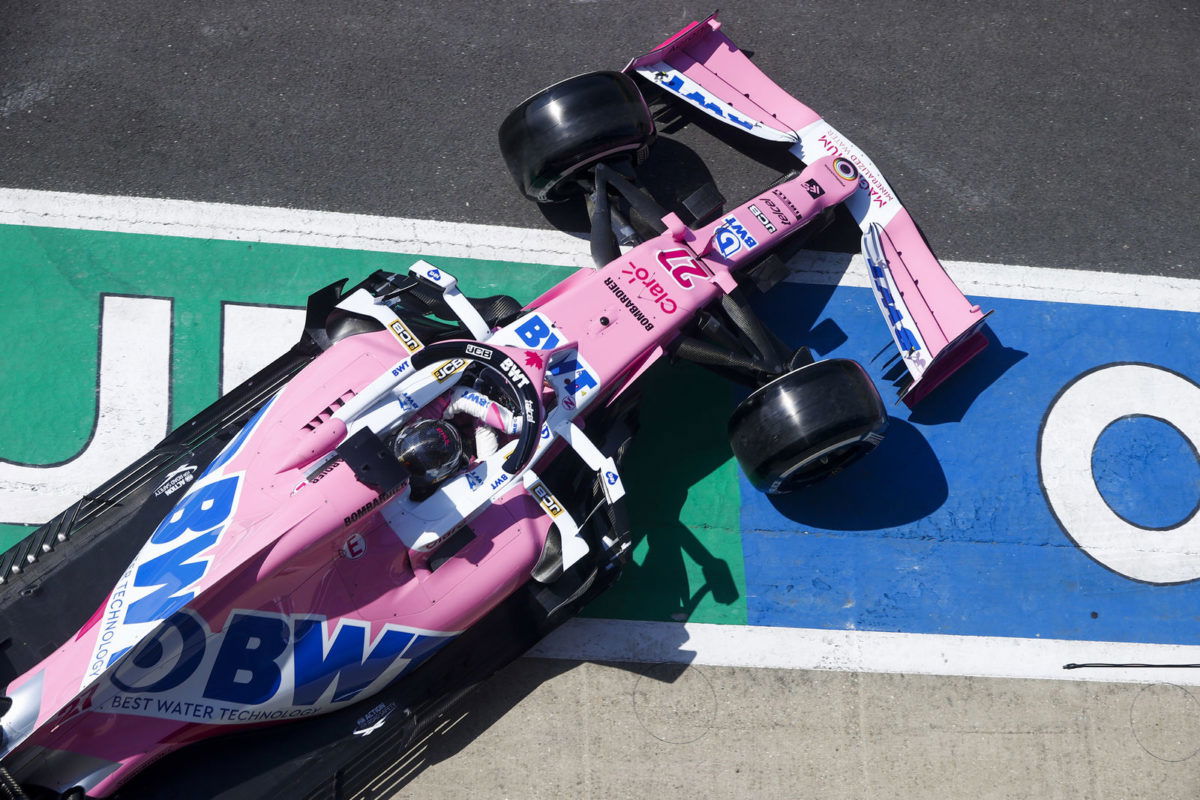

The judgement passed down from the FIA regarding the brake ducts on the Racing Point RP20 has proved one of the most contentious issues in recent Formula 1 history.
Following a protest from Renault initially after the Styrian Grand Prix, on Friday Racing Point was handed a EUR 400,000 fine and docked 15 points in the constructors’ championship.
It’s a penalty the Silverstone-based squad argues is too harsh while rivals in the paddock counter that it’s not harsh enough.
Five teams, including Racing Point itself, have appealed the decision.
The issue
The 2020 Racing Point bears a more than passing resemblance to last year’s all-conquering Mercedes W10, earning it the nickname the ‘pink Mercedes’.
That’s the result of a deliberate design strategy which saw last year’s title winning car reverse engineered, largely from photos, to develop the Racing Point RP20.
However, Renault alleged not all aspects of the car went through the same process, singling out the brake ducts as areas where the team contravened the regulations.
Fundamentally, Renault has questioned how Racing Point arrived at its brake duct designs given their similarity to what Mercedes used last year and the fact it had access to Mercedes’ designs.
In 2019, teams were able to share their brake ducts designs, a practice which has been outlawed with the reclassification of those components to ‘listed parts’ for 2020.
So, while Racing Point was within the regulations last year in having possession of the Mercedes brake duct designs, it’s a question of how it used that information.
What was the penalty actually for?
Boiling it down, Racing Point has been penalised for the design process it followed in developing the rear brake ducts on the RP20.
Even more simply, it’s been penalised for short-cutting the design process by using Mercedes data when it had not last year.
The penalty is therefore not for the components themselves but for the workflow used to arrive at those components.
Racing Point has demonstrated that teams can arrive at remarkably similar designs through reverse engineering processes.
However, in this instance it short-cut that process by using computer aided design (CAD) drawings obtained from Mercedes of its 2019 ducts.
The stewards reasoned that, by skipping the reverse engineering phase of development, the design team gained an advantage as it could focus that energy on other aspects of the car.
The penalty is therefore not for illegal parts, but a means of addressing the design shortcut taken by the team.
Renault boss Cyril Abiteboul explained development of such components was a significant drain on team’s resources during development.
“Just to put things in perspective, any team will be spending 20% of its aerodynamic testing restriction time into developing those parts so it is not small,” he quantified.
The grey area
According to the regulations, and more specifically Appendix 6 of the Sporting Regulations, all listed components must be designed by the team.
However, that the brake ducts transitioned from non-listed in 2019 to listed this year has created something of a grey area.
Last year, Racing Point used Mercedes’ front brake duct design, tweaking it slightly to suit its car.
That the front brake ducts were used last year, and modified by the team before being further refined for 2020, means the FIA is satisfied there is enough Racing Point influence for them to be considered the team’s own design.
However, the same is not true of the rear brake ducts.
Last year’s Racing Point employed a different design philosophy, so while it could have used Mercedes’ rear brake ducts legally, the design did not suit that car and they weren’t used.
When design work began on the 2020 car it was decided to change philosophy.
With the RP20 largely a copy of last year’s Mercedes, the rear brake ducts were a better solution, or at least starting point.
Plans for the rear brake ducts were used as ‘input data’ by Racing Point when formulating the design for their own rear brake ducts.
As they were not used last year, but included in the process this year, the FIA deemed that the rear brake ducts “cannot be considered to be a Racing Point design”, which breaches Article 6 of the Sporting Regulations.
Opportunity for clarification
Regulations for the current Formula 1 season came into effect as of January 1 this year, even though the season didn’t start until July.
Despite that, the practical implications of the rules stretched back prior to the start of this year as teams worked to design their cars for the new season.
During that phase, and specifically September to November last year, Racing Point could have asked for clarification in regards to brake ducts transitioning from non-listed to listed components, the FIA suggests.
It also claims there was a further opportunity in March when the FIA visited Racing Point’s design offices to examine the process it went through to develop the RP20.
Precedents and similar cases
This is not the first time there have been skirmishes in the Formula 1 paddock when it comes to intellectual property and the use of a rival’s data.
In 2007 McLaren was thrown out of the constructors’ championship and fined USD $100 million when its Chief Designer Mike Coughlan was found in possession of Ferrari data.
Others also had access to that information, with Coughlan and three others also fined.
Ironically, in 2007 Renault was also asked to explain itself after it was found to have confidential McLaren data.
At the end of 2015 Mercedes instigated legal action against Benjamin Hoyle, an engineer who left the team to join Ferrari.
Unanswered questions
A key unanswered question throughout this process is the exact involvement of Mercedes.
There is no question of the legality of the relationship between it and Racing Point in 2019 as all the data transferred between the teams was above board.
However it’s not clear why Mercedes gave Racing Point a set of 2019-spec brake ducts on January 6, 2020.
Racing Point argued there was nothing to answer for on that front since the sporting regulations don’t come into play until 24 hours before the start of the season (in this instance, opening practice in Australia).
Team Principal Otmar Szafnauer argued the components were received for use as spares in winter testing at a time when it wasn’t clear if Racing Point’s own designs would be ready in time.
Mercedes team boss, Toto Wolff, suggests the transfer of components was irrelevant as it had no bearing on the design process employed by Racing Point.
In the FIA’s judgement, Racing Points receipt of those Mercedes brake ducts “does not constitute a breach of the regulations worth of censure as the parts in question were both not used and did not expand on the information that had previously passed from Mercedes to Racing Point quite legitimately under the regulations in 2019.”
However, that stance seems at odds with Appendix 6 of the Sporting Regulations, specifically Article 4, which states;
No competitor shall be entitled:
a) To pass on or receive any information on Listed Parts (including but not limited to data, designs or drawings) directly to or from another competitor or via an external entity or third party.
b) To receive or supply consultancy or any other kind of services from or to another competitor directly or via an external entity or third party in relation to Listed Parts.
The appeals
Five teams are set to appeal the decision, one of them being Racing Point itself which believes the penalty is too harsh.
Four others, namely Renault, McLaren, Ferrari, and Williams, have all voiced their intentions to appeal with a view to a harsher penalty.
Exactly what the penalty should, or could, have been is unclear.
Stewards noted that the brake duct design was entirely legal when considered within the Technical Regulations, meaning there are no legality issues when it comes to the component itself.
It does however introduce the concept of ‘grandfathering’ components; the process of using components across multiple seasons (albeit in this instance with design modification).
There is no provision in the regulations for such a term, a point raised by McLaren’s Zak Brown.
Teams initially had 24 hours in which to submit their notice of intent to appeal, and then a further 96 hours to confirm it.





















Discussion about this post